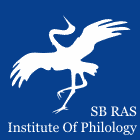 |
|
||||||||||||
|
Institute of Philology of
the Siberian Branch of Russian Academy of Sciences |
|
||||||||||||
|
|||||||||||||
| Sibirskii Filologicheskii Zhurnal (Siberian Journal of Philology) | |
|
Article
Authors: Timofey V. Timkin Institute of Philology of the Siberian Branch of the Russian Academy of Sciences, Novosibirsk, Russian Federation In the section Linguistics
Abstract: This paper describes tongue dorsum coarticulation patterns in “initial consonant – first syllable vowel” sequences in Surgut Khanty based on ultrasound imaging data. Experimental data were obtained from a native speaker using Articulate Instruments equipment. Tongue movements during utterance were recorded with the ultrasound probe, and the images were measured and statistically processed using the AAA and R software. Over one thousand audio segments were processed. Individual sounds were isolated from the sequences through acoustic analysis. Tongue movements were represented as the trajectories of three control points: the tongue tip, dorsum, and root. The analysis revealed that when the initial sound is a coronal consonant, the dorsum moves in anticipation of the following vowel: forward and upward before front vowels, backward and upward before o- and u-vowels, and backward and downward before a-vowel consonants. This process can be characterized as palatalization prior to front vowels, but it is distinct from primary palatal articulation in terms of tongue transition. The initial palatal consonant causes the dorsum to retract and descend, a movement that is minimal before front vowels but more pronounced before raised and retracted vowels. Within sequences featuring initial radical consonants, the tongue can occupy different articulation places: velar or uvular depending on the succeeding vowel. When transitioning from a radical consonant to a vowel, the tongue lowers, with the potential of minimal posterior or anterior movement. Palatalization likely causes the tongue to be more advanced before front vowels. The occurrence of a uvular consonant preceding front vowels is impossible. Keywords: Khanty language, Surgut dialect, ultrasound imaging, experimental phonetics, coarticulation Bibliography: Chepregi M. Surgutskiy dialekt khantyyskogo yazyka [The Surgut dialect of the Khanty language]. Khanty-Mansiysk, 2017, 180 p. Esling J. There are no back vowels: the laryngeal articulator model. Canadian Journal of Linguistics. 2005, no. 50 (1/2/3/4), pp. 13–44. Fowler C. A., Saltzman E. Coordination and coarticulation in speech production. Language and Speech. 1993, no. 36, pp. 171–195. Gick B. The use of ultrasound for linguistic phonetic fieldwork. Journal of the International Phonetic Association. 2002, vol. 32, no. 2, pp. 113–121. Keating P. A. The window model of coarticulation: articulatory evidence. In: Papers in laboratory phonology I: Between the grammar and physics of speech. Cambridge, Cambridge Uni. Press, 1990, pp. 451–470. Kodzasov S. V., Krivnova O. F. Obshchaya fonetika: Uchebnik [General phonetics: A textbook]. Moscow, RSUH, 2001, 592 p. Lemskaya V. M., Tokmashev D. M., Kuz’mina A. I. i dr. Primenenie dannykh ul’trazvukovykh issledovaniy raznosistemnykh idiolektov v praktike izucheniya yazykov korennykh narodov Sibiri i prepodavaniya inostrannykh yazykov [Application of ultrasound research data of multisystemic idiolects in the practice of studying the languages of indigenous peoples of Siberia and teaching foreign languages]. In: Rodnoy i inostrannye yazyki v polikul’turnom prostranstve: Sb. st. Mezhdunar. nauch.-prakt. konf. (Surgut, 01–02 noyabrya 2024 g.) [Native and foreign languages in a multicultural space: Coll. of art. of the Intern. sci. and pract. conf. (Surgut, November 1–2, 2024)]. Surgut, 01–02 November 2024. Surgut State University, 2025, pp. 27–31 Lindblom B. Explaining phonetic variation: a sketch of the H&H theory. In: Hardcastle W. J., Marchal A. Speech Production and Speech Modelling. Dordrecht, Kluwer Academic Publ., 1990, pp. 403–439. Ryzhikova T. R., Timkin T. V., Dobrynina A. A. Yazychnye nosovye soglasnye altayskogo yazyka (rezul’taty elektropalatograficheskogo i ul’trazvukovogo issledovaniya) [Lingual nasal consonants of the Altai language (results of electropalatographic and ultrasonic research]. Tomsk State University Journal of Philology. 2024, no. 88, pp. 92–110. DOI 10.17223/19986645/88/5 Tereshkin N. I. Slovar’ vostochnokhantyyskikh dialektov [Dictionary of East Khanty dialects]. Leningrad, Nauka, 1981, 544 p. Timkin T. V. Glasnye pervogo sloga surgutskogo dialekta khantyyskogo yazyka po dannym ul’trazvukovogo issledovaniya [First syllable vowels in Surgut Khanty according to the ultrasonography data]. Sibirskii Filologicheskii Zhurnal [Siberian Journal of Philology]. 2022, no. 3, pp. 196–211. DOI 10.17223/18137083/80/16 Volenec V. Coarticulation. In: Phonetics. Jasmine Davis (Ed.). New York, Nova Sci-ence Publ., 2015, pp. 47–86. |
 |
Institute of Philology Nikolaeva st., 8, Novosibirsk, 630090, Russian Federation +7-383-330-15-18, ifl@philology.nsc.ru |
© Institute of Philology |


